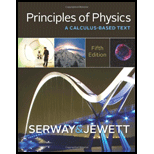
Concept explainers
Consider the three connected objects shown in Figure P5.43. Assume first that the inclined plane is frictionless and that the system is in equilibrium. In terms of m, g, and θ, find (a) the mass M and (b) the tensions T1 and T2. Now assume that the value of M is double the value found in part (a). Find (c) the acceleration of each object and (d) the tensions T1 and T2. Next, assume that the coefficient of static friction between m and 2m and the inclined plane is μs and that the system is in equilibrium. Find (e) the maximum value of M and (f) the minimum value of M. (g) Compare the values of T2 when M has its minimum and maximum values.
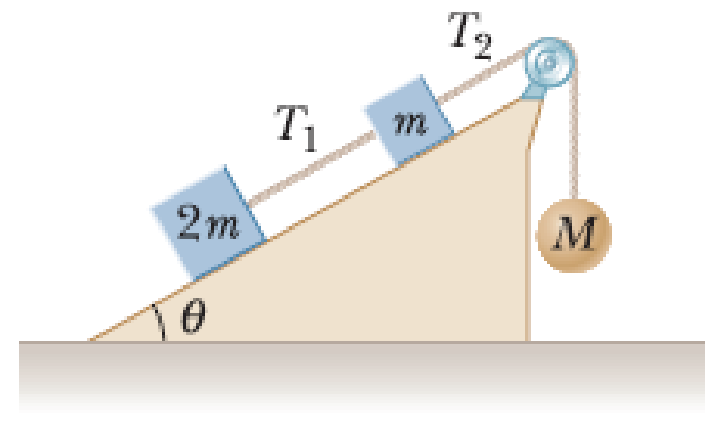
Figure P5.43
(a)
The mass
Answer to Problem 43P
The mass
Explanation of Solution
The free body diagram of the mass
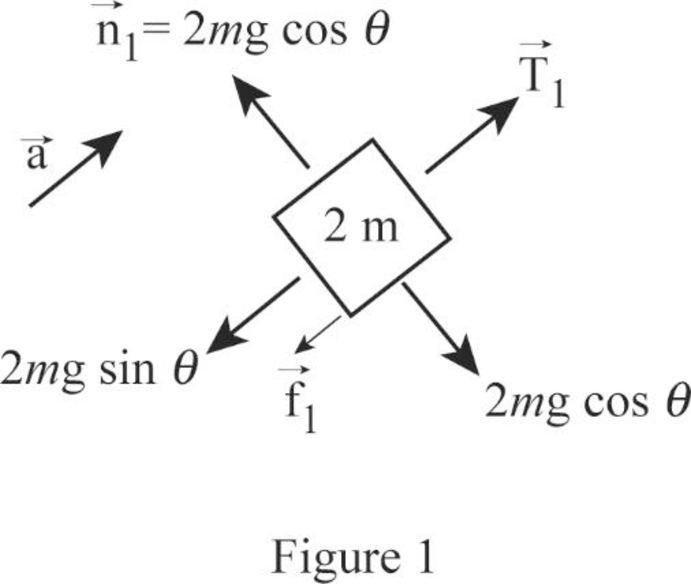
The free body diagram of the mass
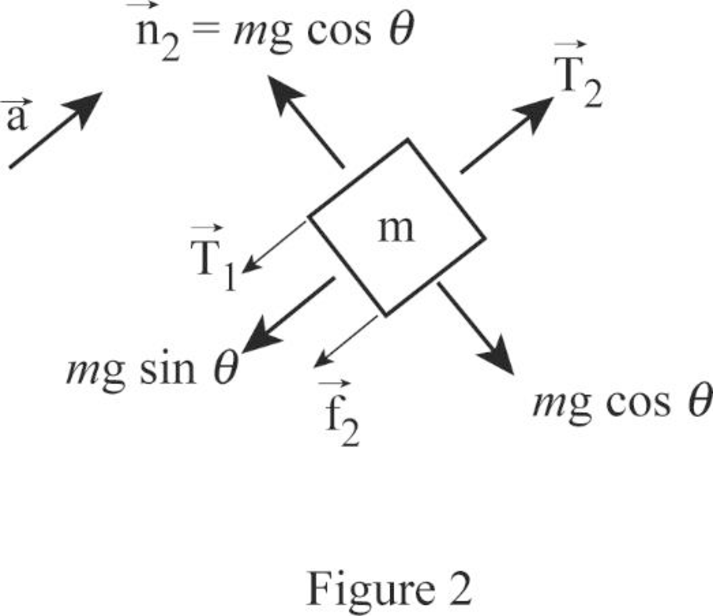
The free body diagram of the mass
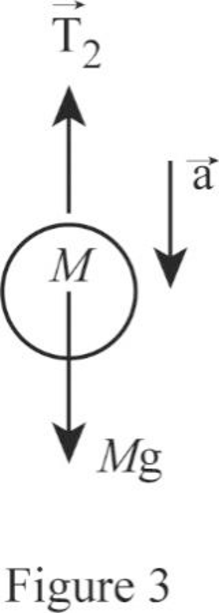
Apply Newton’s second law in the Figure1.
Here,
Apply Newton’s second law in the Figure 2.
Here,
Apply Newton’s second law in the Figure 3.
Assume that, the system is in equilibrium,
Use equation (I) and (III), in (II).
Conclusion:
Therefore, the mass
(b)
The tensions
Answer to Problem 43P
The tension
Explanation of Solution
From the part (a),
Use equation (IV) in (III), and substitute
Conclusion:
Therefore, the tensions
(c)
The acceleration of each object when the value of
Answer to Problem 43P
The acceleration of each object when the value of
Explanation of Solution
Assume that,
Substitute,
Use equation (I) and (V) in (VII), substitute,
Conclusion:
Therefore, the acceleration of each object when the value of
(d)
The tensions
Answer to Problem 43P
The tensions
Explanation of Solution
Use equation (VI) in (I), substitute,
Use equation (VI) in (III), and use
Conclusion:
Therefore, the tensions
(e)
The maximum value of
Answer to Problem 43P
The maximum value of
Explanation of Solution
At the equilibrium the acceleration is zero, and the frictional forces acting down the incline.
Use
Use
Rewrite the equation (III) for
Use equation (IX) and (X) in (XI).
Conclusion:
Therefore, the maximum value of
(f)
The minimum value of
Answer to Problem 43P
The minimum value of
Explanation of Solution
Rewrite the equation (III) for
At the equilibrium the acceleration is zero, and impending motion up the incline, so the frictional forces acting up the incline.
Use
Since the frictional forces acting up the incline.
Use
Since the frictional forces acting up the incline.
Use equation (XII) and (XIII) in (XIV).
Conclusion:
Therefore, the minimum value of
(g)
The value of
Answer to Problem 43P
The value of
Explanation of Solution
Subtract equation (XII) from (XI).
Use
Conclusion:
Therefore, the value of
Want to see more full solutions like this?
Chapter 5 Solutions
Bundle: Principles of Physics: A Calculus-Based Text, 5th + WebAssign Printed Access Card for Serway/Jewett's Principles of Physics: A Calculus-Based Text, 5th Edition, Multi-Term
- Two objects, m1 = 3.00 kg and m2 = 8.50 kg, are attached by a massless cord passing over a frictionless pulley as shown in Figure P5.51. Assume the horizontal surface is frictionless. a. Draw a free-body diagram for each of the two objects. b. What is the tension in the cord? c. What is the magnitude of the acceleration of the two objects? FIGURE P5.51 Problems 51 and 65.arrow_forwardA heavy chandelier with mass 125 kg is hung by chains in equilibrium from the ceiling of a concert hall as shown in Figure P5.77, with 1 = 37.0 and 2 = 64.0. Assuming the chains are massless, what are the tensions FT1, FT2, and FT3 in the three chains? FIGURE P5.77arrow_forwardTwo blocks connected by a rope of negligible mass are being dragged by a horizontal force (Fig. P5.13). Suppose F = 68.0 N, m1 = 12.0 kg, m2 = 18.0 kg, and the coefficient of kinetic friction between each block and the surface is 0.100. (a) Draw a free-body diagram for each block. Determine (b) the acceleration of the system and (c) the tension T in the rope. Figure P5.13arrow_forward
- Initially, the system of objects shown in Figure P5.49 is held motionless. The pulley and all surfaces and wheels are frictionless. Let the force F be zero and assume that m1 can move only vertically. At the instant after the system of objects is released, Find (a) the tension T in the string, (b) the acceleration of m2, (c) the acceleration of M, and (d) the acceleration of m1. (Note: The pulley accelerates along with the cart.) Figure P5.49 Problems 49 and 53arrow_forwardAn object of mass m1 = 5.00 kg placed on a frictionless, horizontal table is connected to a string that passes over a pulley and then is fastened to a hanging object of mass m2 = 9.00 kg as shown in Figure P5.22. (a) Draw free-body diagrams of both objects. Find (b) the magnitude of the acceleration of the objects and (c) the tension in the string. Figure P5.22 Problems 22 and 29.arrow_forwardThree objects are connected on a table as shown in Figure P5.14. The coefficient of kinetic friction between the block of mass m2 and the table is 0.350. The objects have masses of m1 = 4.00 kg, m2 = 1.00 kg, and m3 = 2.00 kg, and the pulleys are frictionless. (a) Draw a free-body diagram of each object. (b) Determine the acceleration of each object, including its direction. (c) Determine the tensions in the two cords. What If? (d) If the tabletop were smooth, would the tensions increase, decrease, or remain the same? Explain. Figure P5.14arrow_forward
- Consider the three connected objects shown in Figure P5.88. Assume first that the inclined plane is friction-less and that the system is in equilibrium. In terms of m, g, and , find (a) the mass M and (b) the tensions T, and T2. Now assume that the value of Af is double the value found in part (a). Find (c) the acceleration of each object and (d) the tensions T1 and T2. Next, assume that the coefficient of static friction between m and 2m and the inclined plane is m, and that the system is in equilibrium. Find (e) the maximum value of M and (0 the minimum value of M. (g) Compare the values of T2 when M has its minimum and maximum values.arrow_forward(a) What is the minimum force of friction required to hold the system of Figure P4.74 in equilibrium? (b) What coefficient of static friction between the 100.-N block and the table ensures equilibrium? (c) If the coefficient of kinetic friction between the 100.-N block and the table is 0.250, what hanging weight should replace the 50.0-N weight to allow the system to move at a constant speed once it is set in motion? Figure P4.74arrow_forwardAn object of mass m1 = 5.00 kg placed on a frictionless, horizontal table is connected to a string that passes over a pulley and then is fastened to a hanging object of mass m2 = 9.00 kg as shown in Figure P4.28. (a) Draw free-body diagrams of both objects. Find (b) the magnitude of the acceleration of the objects and (c) the tension in the string. Figure P4.28arrow_forward
- Two blocks are connected by a rope that passes over a massless and frictionless pulley as shown in Figure P5.41. Given that m0 = 15.93 kg and m2 = 10.45 kg, determine the magnitudes of the tension in the rope and the blocks acceleration. FIGURE P5.41arrow_forwardTwo blocks, each of mass m, are hung from the ceiling of an elevator as in Figure P4.33. The elevator has an upward acceleration a. The strings have negligible mass. (a) Find the tensions T1 and T2 in the upper and lower strings in terms of m, a, and g. (b) Compare the two tensions and determine which string would break first if a is made sufficiently large. (c) What are the tensions if the cable supporting the elevator breaks? Figure P4.33 Problems 33 and 34.arrow_forwardAn object of mass M is held in place by an applied force F and a pulley system as shown in Figure P4.43. The pulleys are massless and frictionless. (a) Draw diagrams showing the forces on each pulley. Find (b) the tension in each section of rope, T1, T2, T3, T4, and T5 and (c) the magnitude of F. Figure P4.43 44. Any device that allows you to increase the force you exert is a kind of machine. Some machines, such as the prybar or the inclined plane, are very simple. Some machines do not even look like machines. For example, your car is stuck in the mud and you cant pull hard enough to get it out. You do, however, have a long cable that you connect taut between your front bumper and the trunk of a stout tree. You now pull sideways on the cable at its midpoint, exerting a force f. Each half of the cable is displaced through a small angle from the straight line between the ends of the cable. (a) Deduce an expression for the force acting on the car. (b) Evaluate the cable tension for the case where = 7.00 and f = 100 N.arrow_forward
 Principles of Physics: A Calculus-Based TextPhysicsISBN:9781133104261Author:Raymond A. Serway, John W. JewettPublisher:Cengage Learning
Principles of Physics: A Calculus-Based TextPhysicsISBN:9781133104261Author:Raymond A. Serway, John W. JewettPublisher:Cengage Learning Physics for Scientists and Engineers, Technology ...PhysicsISBN:9781305116399Author:Raymond A. Serway, John W. JewettPublisher:Cengage Learning
Physics for Scientists and Engineers, Technology ...PhysicsISBN:9781305116399Author:Raymond A. Serway, John W. JewettPublisher:Cengage Learning College PhysicsPhysicsISBN:9781285737027Author:Raymond A. Serway, Chris VuillePublisher:Cengage Learning
College PhysicsPhysicsISBN:9781285737027Author:Raymond A. Serway, Chris VuillePublisher:Cengage Learning College PhysicsPhysicsISBN:9781305952300Author:Raymond A. Serway, Chris VuillePublisher:Cengage Learning
College PhysicsPhysicsISBN:9781305952300Author:Raymond A. Serway, Chris VuillePublisher:Cengage Learning Physics for Scientists and EngineersPhysicsISBN:9781337553278Author:Raymond A. Serway, John W. JewettPublisher:Cengage Learning
Physics for Scientists and EngineersPhysicsISBN:9781337553278Author:Raymond A. Serway, John W. JewettPublisher:Cengage Learning Physics for Scientists and Engineers with Modern ...PhysicsISBN:9781337553292Author:Raymond A. Serway, John W. JewettPublisher:Cengage Learning
Physics for Scientists and Engineers with Modern ...PhysicsISBN:9781337553292Author:Raymond A. Serway, John W. JewettPublisher:Cengage Learning





